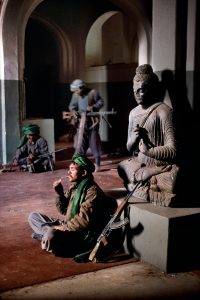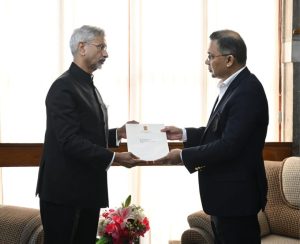Empower Afghan women to destroy Taliban
By Ramananda Sengupta
Chennai, August 29: The only good Taliban is a dead one. The sick psychos, who are a disgrace to the religion they claim to represent, need to be exterminated like the vermin that they are.
Instead, however, because they once again rule Afghanistan, an incredibly beautiful land with an even more incredibly bloodstained history, the world seems to be gradually reconciling with them. And that apparently includes India, which had supported the Northern Alliance, which fought bravely against these ‘religious’ retards when they ruled Afghanistan the last time, from 1996 to October 2001.
During those six or seven years, the Taliban strictly enforced their perverted version of Sharia law across the land, which essentially gave them license to publicly behead anyone who disagreed with them, or had a wife or daughter or property which the local Taliban commander or his bearded cronies coveted.
They started their innings by torturing, castrating and executing former President Mohammad Najibullah, who was supposedly living under UN ‘protection’ at the time in Kabul, and then hanging his corpse from a traffic light pole outside the presidential palace to show that the country was under a new leadership.

Women were told they could step out of their homes only after ensuring that not even a square centimetre of their skin was visible, and had a male relative accompanying them. Music and singing was strictly taboo. Suspected homosexuals were tortured and thrown off tall buildings and cliffs. Children were forced to watch their friends and relatives being beheaded in public squares and even stadiums.
And this applied not just to people, but to things like the Bamiyan Buddhas, the two massive (175 and 120 feet respectively) sixth century carvings which stood against everything the Taliban epitomised in the Bamiyan valley, right in the middle of the country. Tanks and rockets were brought in to raze the sculptures carved into the rock faces, to ensure that the local population was no longer subject to the Buddha’s benevolent gaze.
The Kabul national museum– which housed over 100,000 artefacts and items from Persian, Buddhist, and Islamic dynasties across several millennia, making it one of the most important repositories of not just Afghan, but Central and South Asian culture — was looted and vandalised soon after Kabul fell to the Talib, which, ironically, means student. Some of these artefacts soon surfaced in private collections and museums across the world, which shows that the pillaging mobs -or at least a part of them — were not averse to profiting from these ‘offensive’ pieces of history.
But bar some token assistance to the Northern alliance led by Ahmad Shah Masoud, which heroically held on to a small sliver of mountainous territory in northern Afghanistan, most of the ‘civilised’ world tut-tutted and looked the other way. And the country soon turned into a terrorist swamp, run by a toxic mixture of drug lords and warlords who claimed to rule in the name of Allah the Merciful.
Pakistan, which has always coveted its western neighbour because of the ‘strategic depth’ it provided against India – was the first of three nations which formally recognised the Taliban government. (Which is not surprising, given that the outfit’s founder Mullah Omar, the one-eyed maniac and former Mujahideen who fought against the Soviets in Afghanistan, was a certified lapdog of Pakistan’s ISI).
The others were Saudi Arabia, the birthplace of ‘exiled’ Al Qaeda chieftain Osama Bin Laden who found refuge in Afghanistan in 1996, and the UAE.

It was only after the Al Qaeda was named as the perpetrator of the 9/11 attack in the US, and the subsequent refusal by the Taliban to hand over Osama to the Americans, that Operation ‘Enduring Freedom’ was launched. The carpet bombing of Taliban and Al Qaeda strongholds had their leadership scurrying to Pakistan, where the former regrouped with the ISI’s help to continue the good fight against the ‘invading forces.’
Then Pakistani President and dictator Pervez Musharraf played both sides, charging the US a fortune for allowing a supply line to its forces deployed in Afghanistan, and using some of that money to fund the Taliban, which conducted hit and run operations against Allied Forces in Afghanistan before returning to the badlands of western Pakistan.
His successors at GHQ Rawalpindi continued the practice, even as they played golf with American Military Brass at the plush Fort Belvoir Golf Club in northern Virginia (a rigorous 36 Holes) and the relatively easy 54 holes at Andrews Air Force Base in suburban Maryland.
It took 20 years, trillions of dollars and the loss of thousands of lives, mostly Afghan civilians caught in the crossfire, and a fake peace process brokered by Pakistan, for the US to realise that it was not their war, and abruptly hand the country back to the Taliban. Which promptly went back to its bad old ways, taking the country back to the dark ages.
But this time, apparently in order to protect the billions of dollars it invested in building infrastructure and goodwill in Afghanistan during those 20 years, New Delhi has decided to see if it can become friends with the Taliban. Talk of ensuring some aid reaches the women and children facing an extremely bleak winter in Afghanistan is pure manure, given that the Talibs themselves are also going to be starving, and have already shown their total disregard for women or children. Pakistan, which can barely feed itself at the moment, is unlikely to be of much help.
Hopefully, the killing of Osama’s insipid successor Ayman Al Zawahiri by a US missile in downtown Kabul, and the Taliban’s increasing atrocities against its own people will make New Delhi reconsider, and perhaps even join the anti-Taliban movement. Because cosying up to a government which has taken over with no legal mandate, and has several leaders who are certified as terrorists by the UN and other world bodies, while at the same time proudly proclaiming that we do not deal with terrorists is a peculiarly uncomfortable position to be in.
A good place to start would be Afghan women, who tasted some freedom during these 20 years, and are loath to lose it again. No, I am certainly not recommending the raising of a Burkha Rifles Battalion. But if we must talk with the bigots, how about sending our top women diplomats to do so? How about urging/nudging/demanding or even making it a precondition that their delegation too must have at least one woman, if not more, and ensure that we engage with her more than we do with the men?

How about insisting that any aid that we distribute there would be divided equally between men and women, and ensure that those physically distributing the aid are women? Why not invite delegations or even former members of Razwana, which worked to raise awareness of women’s rights and provide legal advice, the Afghan Women’s Network, the Afghan Women’s Council and the Revolutionary Association of the Women of Afghanistan to India for conferences and seminars?
By overtly and covertly supporting and empowering Afghan women, who comprise almost half (105.33 males per 100 females) the country’s population, we would certainly give the Taliban something to worry about. Because although British playwright William Congreve meant in a different context way back in 1697, we all know that hell hath no fury like a woman scorned.
(The author is an independent foreign and strategic affairs analyst. The views expressed do not necessarily reflect those of this publication)






